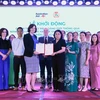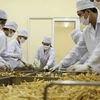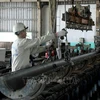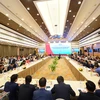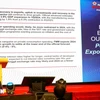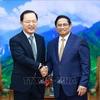Vietnam 's textile and garment businesses should develop their service centres, especially the industry's small- and medium-sized enterprises (SMEs), participants were informed at a workshop held in Hanoi on Oct. 20.
This workshop on Capacity Building for Service Centres to Develop SME Cluster was part of a 3 million-EURO (4.28 million USD) development project funded by the Italian government and implemented by the United Nations Industrial Development Organisation (UNIDO) and the Enterprise Development Agency (EDA) under the Vietnamese Ministry of Planning and Investment.
The main objective of this project is to contribute to the sustainable development of Vietnamese SMEs: increasing their competitiveness, upgrading the quality of their products, and improving their access to international markets. A key approach for improving SME competitiveness was the establishment of industry clusters, strengthening connections between businesses in order to create an environment that facilitates innovation and sustainable development.
In a speech delivered at the event, Italian Ambassador to Vietnam Lorenzo Angeloni said his government had paid attention to SME cluster development within UNIDO and believed SMEs had played an important role in the economy.
He said Vietnam should attempt to build trademarks by studying the examples of foreign countries, adding that Italy would be a good partner for a middle-income country like Vietnam .
EDA's deputy director cum national project director Nguyen Trong Hieu said the project had been implemented for nearly three years in Vietnam , aiming to increase competitiveness and restructuring businesses.
"A service centre in the north would help textile and garment businesses meet export requirements," he said.
Patrick Gilabert, UNIDO representative in Vietnam , agreed, adding that the centres would also meet the requirements of domestic firms for design, export promotion, and marketing information.
Enrico Ottolini, senior project advisor of International T&G Advisor, said service centres would provide testing, training, technology consultation and opportunities for applied research. They would focus on building competence and teaching the skills needed for sector development.
"The establishment of the centre is a result of public-private consensus between local and national stakeholders. The centre will have private soul but a public vision," he said.
He added that Vietnam had strongly supported the decision to upgrade the Textile Research Institute (TRI) as one kind of centre that would offer a wide array of services, ranging from product design to export promotion to waste management and pollution control.
Statistics from Vietnam T&G Industry showed that the country has employed nearly 2 million people, with direct labourers numbering around 1.1 million. It has about 4,000 enterprises with the State as a major shareholder, accounting for 77.5 percent of the companies.
Export turnover this year was estimated to reach an average of 1 billion USD per month.
It also forecast that textile and garment production would move from East European countries to Asian ones in the next three to four years.
"It would be a good time for Indian, Bangladeshi, Pakistani, Vietnamese and Cambodian clothing manufacturers to expand production," he said.
He expected that the value of the testing market in Vietnam would soon reach 20 million USD per year and have a market growth rate of 10 percent per year.
"Lab equipment produced by Vietnam 's organisations were thought to be modern and accurate enough to provide reliable tests. Vietnamese technicians are able to perform their jobs effectively," he added.
Director of HCM City's Concetti Consultancy Centre Han Manh Tien said the centre must be able to interact with local companies and associations, providing customised consultations for the development of new projects./.
This workshop on Capacity Building for Service Centres to Develop SME Cluster was part of a 3 million-EURO (4.28 million USD) development project funded by the Italian government and implemented by the United Nations Industrial Development Organisation (UNIDO) and the Enterprise Development Agency (EDA) under the Vietnamese Ministry of Planning and Investment.
The main objective of this project is to contribute to the sustainable development of Vietnamese SMEs: increasing their competitiveness, upgrading the quality of their products, and improving their access to international markets. A key approach for improving SME competitiveness was the establishment of industry clusters, strengthening connections between businesses in order to create an environment that facilitates innovation and sustainable development.
In a speech delivered at the event, Italian Ambassador to Vietnam Lorenzo Angeloni said his government had paid attention to SME cluster development within UNIDO and believed SMEs had played an important role in the economy.
He said Vietnam should attempt to build trademarks by studying the examples of foreign countries, adding that Italy would be a good partner for a middle-income country like Vietnam .
EDA's deputy director cum national project director Nguyen Trong Hieu said the project had been implemented for nearly three years in Vietnam , aiming to increase competitiveness and restructuring businesses.
"A service centre in the north would help textile and garment businesses meet export requirements," he said.
Patrick Gilabert, UNIDO representative in Vietnam , agreed, adding that the centres would also meet the requirements of domestic firms for design, export promotion, and marketing information.
Enrico Ottolini, senior project advisor of International T&G Advisor, said service centres would provide testing, training, technology consultation and opportunities for applied research. They would focus on building competence and teaching the skills needed for sector development.
"The establishment of the centre is a result of public-private consensus between local and national stakeholders. The centre will have private soul but a public vision," he said.
He added that Vietnam had strongly supported the decision to upgrade the Textile Research Institute (TRI) as one kind of centre that would offer a wide array of services, ranging from product design to export promotion to waste management and pollution control.
Statistics from Vietnam T&G Industry showed that the country has employed nearly 2 million people, with direct labourers numbering around 1.1 million. It has about 4,000 enterprises with the State as a major shareholder, accounting for 77.5 percent of the companies.
Export turnover this year was estimated to reach an average of 1 billion USD per month.
It also forecast that textile and garment production would move from East European countries to Asian ones in the next three to four years.
"It would be a good time for Indian, Bangladeshi, Pakistani, Vietnamese and Cambodian clothing manufacturers to expand production," he said.
He expected that the value of the testing market in Vietnam would soon reach 20 million USD per year and have a market growth rate of 10 percent per year.
"Lab equipment produced by Vietnam 's organisations were thought to be modern and accurate enough to provide reliable tests. Vietnamese technicians are able to perform their jobs effectively," he added.
Director of HCM City's Concetti Consultancy Centre Han Manh Tien said the centre must be able to interact with local companies and associations, providing customised consultations for the development of new projects./.


